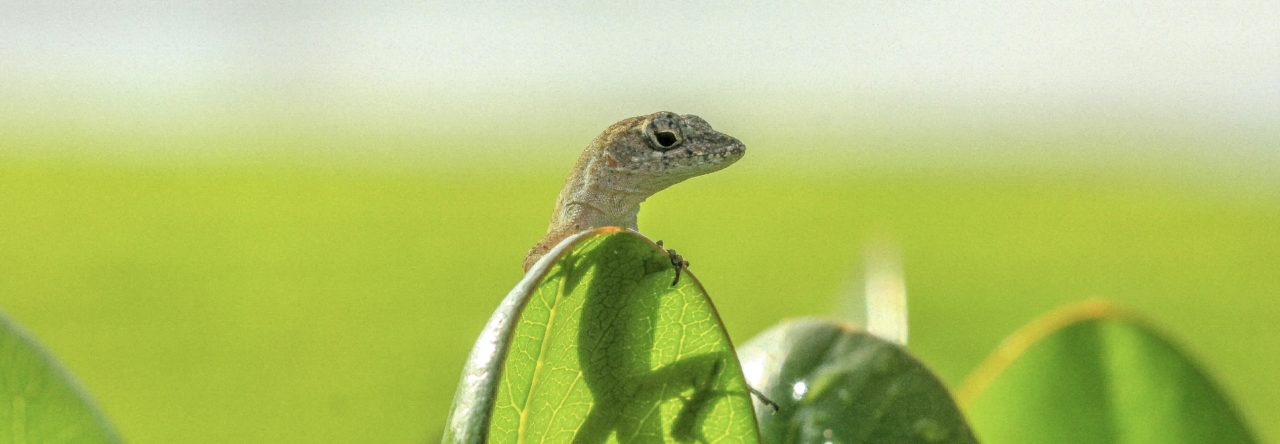
Anolis krugi. Photo by Manuel Leal from the Leal Lab webpage
Anole biologists are fascinated by the variation in dewlap colors and patterns both within and between species. One popular hypothesis is that dewlaps are adapted to be easily detectable against the background in which they are found. A variety of tests have been published, correlating dewlap colors with ambient light, background vegetation and other characteristics. Now Alex Gunderson and colleagues have developed an experimental method of directly testing the hypothesis. Manuel Leal, a coauthor on the paper, reports on the pages of Chipojo Lab, reprinted here:
Brighter is not always better
Those that follow the Chipojoblog are familiar with one of our core tenets: strive as best you can to design experiments under natural conditions. This philosophy reflects my own view that behavior should be studied in the field whenever possible. Our recent paper in Current Zoology, “Visual playback of colorful signals in the field supports sensory drive for signal detectability,” is a prime of example of the power of this approach, in which an intimate understanding of the ecology and behavior of anoles was used to test a major prediction of the sensory drive hypothesis: are signals locally adapted? In other words, are dewlaps locally adapted to effectively grab the attention of an inattentive receiver?
Over the years we have published a series of papers supporting the hypothesis that dewlap diversity can be partially explained by selection to increase the probability of detection. However, until this paper, experimental evidence from the field was missing, in part because manipulating dewlaps of live anoles is not trivial. Furthermore, even if we were able to successfully manipulate dewlaps, there are still many other signals (e.g., body color, motion pattern, size and posture) that would be out of our control. This problem was solved by researchers working with acoustic signals a long time ago by figuring out ways to play the signal of interest in isolation in what have become known as ‘playback experiments.’ We stole a page from their book and constructed a remote-control dewlap apparatus, which provided an opportunity to display only the dewlap under natural conditions (see gizmo below). Alex’s building and painting skills was key to the success of this gizmo. He was able to construct dewlaps with similar reflective and transmission properties of real dewlaps while taking into account the visual system of the anoles (please see papers for details).
 |
| Control-remote dewlap display apparatus. A) Acrylic box within which electrical components were housed. B) Electrical components. C) The apparatus at a mesic site with a fake dewlap displayed. |
Besides presenting the dewlaps in the field, we wanted to test the hypothesis that the dewlaps are locally adapted. Under this hypothesis, increased detection in one habitat comes at the cost of decreased detection in another habitat. This functional approach to test for adaptive value of a trait is commonly used as robust evidence to support selection favoring the evolution of the trait in question. In this paper we tested if the observed differences in dewlap brightness between xeric and mesic populations of Anolis cristatellus is adaptive. If so, dewlaps from mesic populations should be more detectable in mesic habitats and dewlaps from xeric habitats should be more detectable in xeric habitats. Furthermore, detection probability should decrease in the ‘wrong’ habitat. Below are the results of the experiments. In A. cristatellus individuals from xeric habitats have dewlaps which are darker, that is less brighter, than individuals from mesic populations.
 |
| Responses of free-ranging A. cristatellus to fake dewlaps that mimic the brightness properties of real dewlaps. |
Our findings support the sensory drive hypothesis and strongly suggest that the brightness properties of A. cristatellus dewlaps are locally adapted via selection on signal detectability. Furthermore, we have demonstrated that a brighter signal is not always the most detectable or effective signal. A common misconception, which is partially the result of not including the sensory system and habitat conditions as part of the analysis. Studies addressing potential functions and selective forces promoting the diversity of dewlaps found in anoles have flourished over the last decade, nevertheless, these results are the best experimental evidence that we have to support the hypothesis that diversity of dewlap colors might be partially explained by local adaptions to habitat light conditions and the best smoking gun to support the idea that diversity of dewlap colors can be the result of local adaptations to habitat light conditions. Additionally, our study once again underlines the need to measure both reflection and transmission when asking questions regarding the potential function of the dewlap because the two combine to determine dewlap coloration (brightness, coloration, etc.) in the real world.
- Evolution in Real Time on Lizard Island - March 23, 2025
- Spider Snags Adult Anolis osa - March 22, 2025
- An Homage to the Green Anoles of New Orleans - March 21, 2025


4 Pingbacks